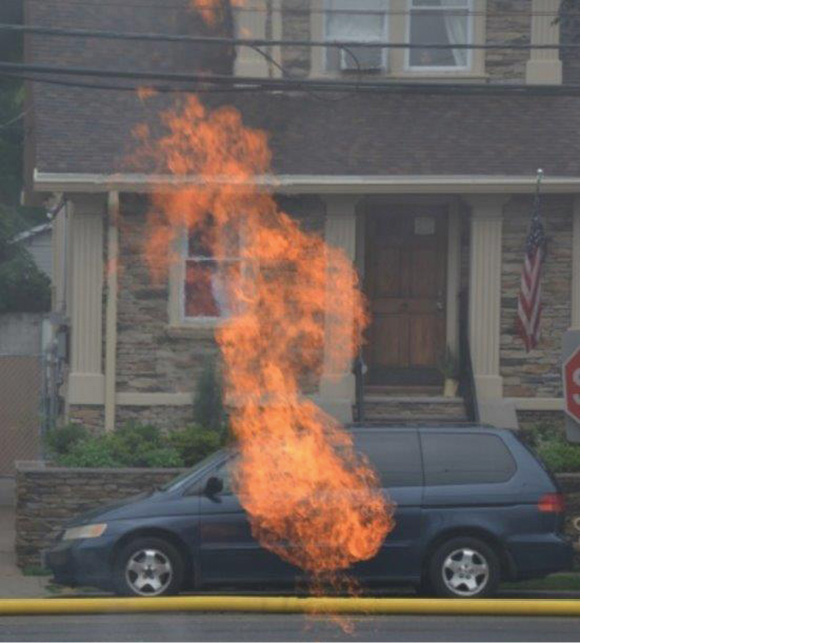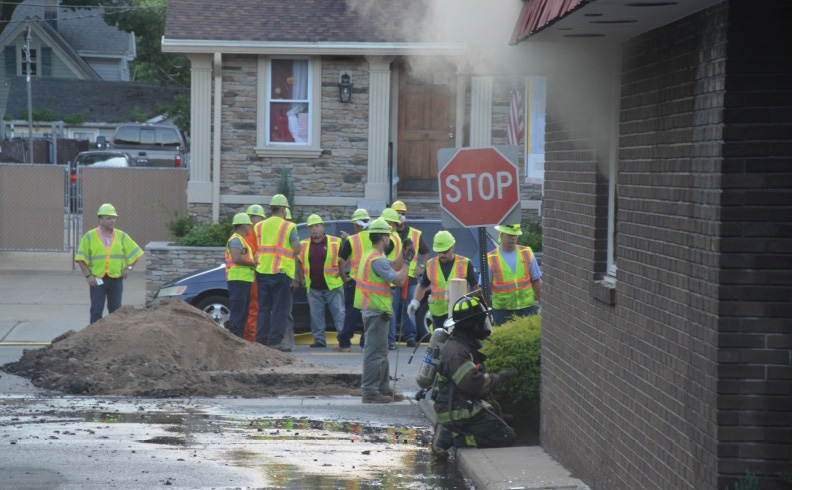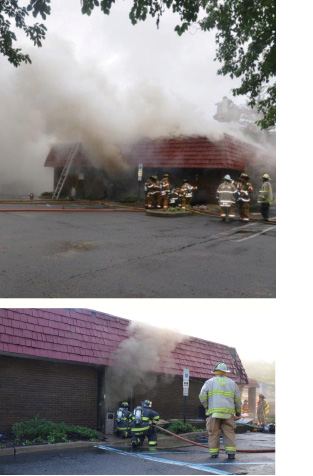
volunteers corner ❘ By STEVEN SULCOV
On July 7, 2017, at approximately 1100 hours, the Fair Lawn (NJ) Police Department began receiving numerous 911 calls for a transformer fire on Lincoln Avenue. The Fair Lawn (NJ) Fire Department (FLFD) was dispatched. The first-arriving fire chief reported a high-tension wire on fire and immediately requested the local utility company to secure the power to the line.
Within minutes of the deputy’s arrival, a loud explosion occurred, sending road debris and concrete flying into the air. The explosion was caused by the failure of the high-tension wire that had landed on a nearby bank’s gas service curb box, which punctured the gas line. This puncture allowed for high-pressure natural gas to begin leaking; the gas then ignited from the electricity coming from the downed line at the street curb. The gas company was notified of the situation and requested to expedite its response.
Fire Company Arrivals
As companies began to arrive and execute their assigned tasks, smoke was emanating from the bank in front of where the gas line had ruptured. A working fire dispatch and second alarm were transmitted quickly to bring additional resources to the scene; this was now a utility fire in the street as well as an apparent structure fire.
As crews made entry and attempted to advance to the basement, the smoke and fire conditions began to change rapidly, resulting in a change in fire attack operations. Reports from companies indicated that there was a gas-fed fire in the basement of the bank and that companies were unable to secure the building’s utility. Later investigations revealed that the backpressure of the gas from the fire that had originated outside had ruptured the gas meter within the structure. Our only option was to shut down the service from the street, which at the time was on fire.
Additional alarms were requested as the incident progressed; this brought additional staffing as well as backfill fire companies from the borough to the scene to respond to additional requests for service. The temperature that day was well above 80°F, which took its toll on the firefighters, limiting their operational time. The only thing the members could do was keep the fire in check.
Based on initial reports from the fire attack and search crews, our department was unaware of the source of the fire inside the building; we assumed the fire was indeed gas-fed, as the companies indicated. With this information—or lack thereof—we had to ensure that we did not put out the fire in the building; extinguishing it could lead to free-flowing natural gas entering the building, which would need only a spark or an ember to ignite.

(1) The high-pressure gas main on fire at the street. (Photos by Jon Ryan.)
Problem in the Basement
As companies continued to keep the fire in the building at bay, we ran into our next problem: the water rapidly filling up the bank’s basement. Fearing that the quickly rising water would extinguish the fire in the basement, we began a basement dewatering operation while simultaneously flowing water into the building.
The utility company was trying valiantly to shut down the gas leaking into the street to allow the FLFD to enter the building and finish the job. Because the line had fallen on the service box, the utility company worker was unable to simply turnkey the gas service and cut off the gas to the building. He could not shut down the 20-inch gas main under high pressure as rapidly as many would expect. The main had to be throttled down from a service yard nearly 30 road miles away. In turn, we were looking at throttling down high-pressure gas through hundreds of miles of pipe. Unbeknownst to the FLFD, a gas main is not the same as a water main. Although turning valves above and below the break can shut down water mains, a gas main is completely different. In the end, the incident rose to five alarms, bringing responses from nearly a dozen neighboring communities. The incident lasted until approximately 2345 hours.

(2) Smoke is showing from the roof of the building, indicating a fire within the building.
Lessons Learned
Following are lessons the FLFD learned from this day and in the days that followed:
- Staffing is our most valuable resource (in more ways than one). As the demands of staffing continue to increase, we must think about the adverse effects staffing has on other organizations in the community; as we maintain staffing on the scene of an incident, another organization somewhere in the community is losing its workforce. One example of this is the Department of Public Works (DPW). Many department members are also employees of the DPW. All fire departments must rely on the DPW to assist them at fires and other emergencies. With all those members committed to the emergency, who in the DPW will help them and us? Management of resources and staffing is NOT just related to on-scene personnel.
-
It’s not about making people happy. Resource management in the volunteer fire service can be one of the most trying issues leaders face. So, how do we keep members in the fold, interested and intrigued to serve their community for free? By offering them the opportunity to be engaged for the duration of any fire, no matter how long it may be. Unfortunately, on this day, this was an unsafe act, and it became a hazard to other firefighters, the firefighting operation, and the firefighters themselves. Because this incident featured 80°F temperatures, command-level personnel had to determine how to rotate our members through rehab and, ultimately, off the fire scene. At the incident’s five-hour mark, we were told that the gas company might not be able to secure the gas until approximately midnight. At that point, command officers had to make a decision to send our first-arriving companies home to rehab and rest; this decision did not make people happy, and we did not expect it to. Their companies would return to the fire in four hours, and we would then replace them with mutual-aid companies. We weren’t there to make people happy; we were there to do a job!

(3) Utility company workers on the scene. Having an identification system would assist the fire department in understanding which people play which role on the scene of the incident.
-
Work with your outside partners to build a progressive and an effective relationship. On a day when resources were stretched to the maximum and we needed outside agencies to assist us with mitigating the emergency, we were met with some significant struggles. The fire department is great at putting out fires, yet we have minimal knowledge of utilities. That knowledge is greatly lessened when dealing with high-pressure gas mains. With this, our utility company brought upward of 35 people to the scene. Resource management at the scene of a fire is already a difficult task, so we need to find a way to ensure that we know who the decision makers and key players from the outside agencies are. This entails identifying who is in charge, who the engineers are, and who is responsible for what will increase the effectiveness of everyone working on the scene of an incident. Invite the key decision makers into the command post; ensure that they have a working knowledge of incident command prior to an incident; and give them something such as a hard hat, a vest, a shirt, and so on, which identifies them as key people in the decision-making process.

(4, 5) Fire officials and utility company representatives meet to discuss the status of the gas emergency in the street.
-
Continue to progress through interagency partnerships. This was an uncommon incident; several factors and complexities made it different from a “normal” incident. We met with the utility company postincident to discuss any potential improvements we could make based on what we learned or gained though this incident. Explaining to the utility company employees what we saw from a fire service perspective and then fielding their questions or concerns from their perspective will continue to help us not only maintain our mutual quality relationships but also ensure that the concerns identified that day are addressed so they are not repeated at future incidents.

(6) Early smoke conditions in the fire building. (7) Companies keep the visible fire at bay without extinguishing the fire inside the building.
In the end, it is important to remember that we don’t have all the answers. We need our outside partners to assist us in mitigating emergency situations. We must take care of ourselves and one another; if this means making some people unhappy for the betterment of their health and safety, then that is what it takes. We learned that, as volunteers, when we are summoned to duty, we might be taking away from other valuable assets in the community. Working together and understanding each role and responsibility on the fireground are essential in the mitigation of emergencies.
STEVEN SULCOV is a 13-year fire service member and a battalion chief for the Fair Lawn (NJ) Fire Department. He has a master of public administration degree in fire and emergency services from Anna Maria College and a bachelor of science degree in fire and safety engineering technology from Eastern Kentucky University.
Related training:
http://emberly.fireengineering.com/articles/2016/07/throw-back-to-basics-utility-control.html
http://emberly.fireengineering.com/articles/2017/04/construction-concerns-utility-meters.html

